The connection between Bergamo and Protestantism is closer than it may appear at first glance. For over four centuries, the city has been home to a community of Evangelical faith actively participating in the economic, social and urban development of the region.
The initial members of this community were Swiss, hailing from Glarus, Zurich and the Grisons. They entered Italy through the San Marco Pass, traversed Valtellina, passed through Cornello dei Tasso and followed the Via Mercatorum trail to the plains. Primarily merchants engaged in the cotton and silk trade, they were part of the weaving industry which was a significant source of income for 16th-century Bergamo. Benefiting from the annual St. Alexander's Fair and the climate of religious tolerance established by the Republic of Venice, these merchants permanently settled in the city during the 18th century, integrating with the existing social fabric while preserving their identity.
Their entrepreneurial acumen translated into economic success, with many reinvesting in the textile industry, family residences and charitable works. Various testimonies of this cultural and artistic enrichment remain, providing a new perspective on the center of Bergamo.
The starting point of this itinerary is the monumental building that perhaps best reflects the destinies and commitment of the Bergamo Protestant community: Palazzo Frizzoni.
The connection between Bergamo and Protestantism is closer than it may appear at first glance. For over four centuries, the city has been home to a community of Evangelical faith actively participating in the economic, social and urban development of the region.
The initial members of this community were Swiss, hailing from Glarus, Zurich and the Grisons. They entered Italy through the San Marco Pass, traversed Valtellina, passed through Cornello dei Tasso and followed the Via Mercatorum trail to the plains. Primarily merchants engaged in the cotton and silk trade, they were part of the weaving industry which was a significant source of income for 16th-century Bergamo. Benefiting from the annual St. Alexander's Fair and the climate of religious tolerance established by the Republic of Venice, these merchants permanently settled in the city during the 18th century, integrating with the existing social fabric while preserving their identity.
Their entrepreneurial acumen translated into economic success, with many reinvesting in the textile industry, family residences and charitable works. Various testimonies of this cultural and artistic enrichment remain, providing a new perspective on the center of Bergamo.
The starting point of this itinerary is the monumental building that perhaps best reflects the destinies and commitment of the Bergamo Protestant community: Palazzo Frizzoni.
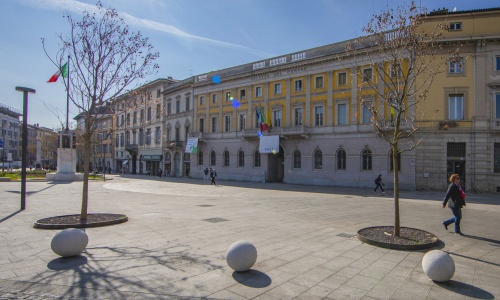
Built in the years 1836-40 at the behest of Enrico Frizzoni, the last representative of one of the major Waldensian families of the city, Palazzo Frizzoni is a magnificent Neoclassical building now serving as the Bergamo City Hall. Inside, you will find beautifully-decorated rooms and an art gallery housing more than 80 paintings.
Two streets leading to Piazza Matteotti are also connected to Waldensian history: via Sant'Orsola and via Borfuro. These streets housed the first "home" churches of Bergamo Protestants, initially in via Sant'Orsola with the Bonorandi family and later in Via Borfuro with the Mariton family, who were related to the Blondels, from whom Enrichetta - wife of Alessandro Manzoni - would be born.
To follow the itinerary take via Borfuro and, at the end, turn left onto Via Sant'Alessandro. After about 120 meters, on your left, you will find via Sant'Orsola, which will you back to the area of Palazzo Frizzoni.
Built in the years 1836-40 at the behest of Enrico Frizzoni, the last representative of one of the major Waldensian families of the city, Palazzo Frizzoni is a magnificent Neoclassical building now serving as the Bergamo City Hall. Inside, you will find beautifully-decorated rooms and an art gallery housing more than 80 paintings.
Two streets leading to Piazza Matteotti are also connected to Waldensian history: via Sant'Orsola and via Borfuro. These streets housed the first "home" churches of Bergamo Protestants, initially in via Sant'Orsola with the Bonorandi family and later in Via Borfuro with the Mariton family, who were related to the Blondels, from whom Enrichetta - wife of Alessandro Manzoni - would be born.
To follow the itinerary take via Borfuro and, at the end, turn left onto Via Sant'Alessandro. After about 120 meters, on your left, you will find via Sant'Orsola, which will you back to the area of Palazzo Frizzoni.
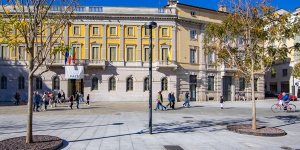
The Palace was named after the family who built it and lived there over more than 90 years, till Enrico Frizzoni decided to leave it to Bergamo, so that it could host the City Hall. Designed by Rodolfo Vatini, Palazzo Frizzoni was built between 1836 and 1840 in a beautiful neoclassical style: the twelve Corinthian pilasters separating the façade’s windows remind of the Roman architecture, as well as the arcade with the eight Ionian columns you will find inside.
During the institutional celebrations, you can also visit the interiors of the Palace! On top of the staircase there is the Hall used for the municipal council meetings. On the other side, if you enter the Mirrors Hall you can admire the wonderful mosaic floor featuring the Frizzoni emblem, consisting of two arrows bound by a ribbon. On the ground floor, go visit the Galleria dei Cardinali: you will find the portraits of Bergamo’s cardinals, including Angelo Roncalli’s, who became Pope John XXIII. Palazzo Frizzoni is also a picture gallery: in fact, it hosts 80 paintings coming from the Accademia Carrara.
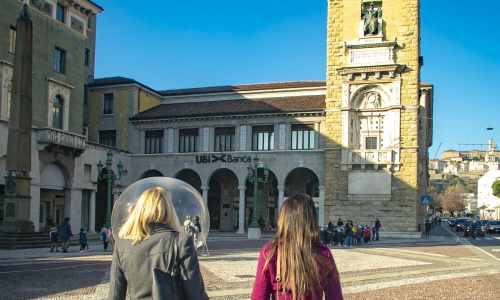
Keeping Palazzo Frizzoni to your left, go straight and cross Piazza Matteotti to reach the pedestrian crossing. From here, turn left onto viale Roma. After approximately 130 meters, on the left at number 2/a, you will encounter another important building, linked in this instance to contemporary history as well: the Temple of the Evangelical Community.
Usually open on Sunday mornings for religious services, it is an excellent example of 19th-century Neo-Renaissance architecture.
Keeping Palazzo Frizzoni to your left, go straight and cross Piazza Matteotti to reach the pedestrian crossing. From here, turn left onto viale Roma. After approximately 130 meters, on the left at number 2/a, you will encounter another important building, linked in this instance to contemporary history as well: the Temple of the Evangelical Community.
Usually open on Sunday mornings for religious services, it is an excellent example of 19th-century Neo-Renaissance architecture.
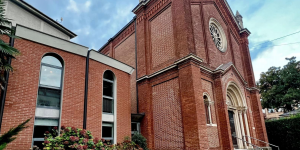
Located in the Lower City, opposite the Bank of Italy headquarters, the Temple is the place of worship for the Bergamo Protestant community.
It was built in the second half of the 19th century based on the design by architect Giacomo Frizzoni. The inauguration took place - as the inscription in the atrium recalls - on April 30, 1876. Thus, the second Protestant place of worship in Lombardy was born, second only to Milan. At the laying of the last stone, the Reformed Community of Bergamo was just sixty-nine years old. It was officially founded during the Napoleonic era (1807) by a group of Protestant merchants and entrepreneurs, mostly of Swiss origin, like most of the Reformed settled in the city. The most prominent among them were also the financiers of the Temple, through land or monetary donations. This includes the Frizzoni family, who offered the plot of land on which the building now stands; old prints and paintings show that originally, the building was surrounded by meadows and small woods, all owned by Palazzo Frizzoni.
The style of the Temple is Neorenaissance with strong references to the Romanesque and the work of Boniforte Solari (15th century) in the clean lines of the architecture and the use of materials typical of Lombard tradition: terracotta for the walls and stone for the sculptural elements. The façade is gabled, decorated with arches, pilasters, and a subtle alternation of brick-colored shades. The entrance is in the center of the lower span and is surmounted by round arches, as are the two side windows. The standout features include the Christ with angels in the lunette and the beautiful rose window in the upper span. Inside, there is a wooden-stone pulpit, an exquisite marble baptismal font, and a Lingiardi organ from Pavia, placed on the internal gallery overlooking the entrance. The apse is adorned with three polychrome stained glass windows representing the risen Jesus Christ and the apostles Paul and John.
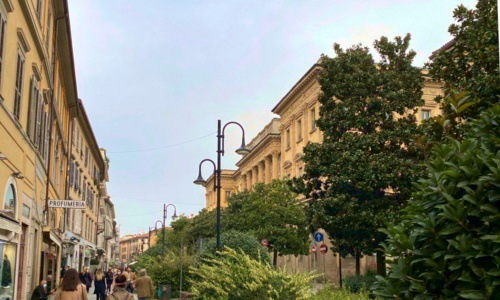
To reach the final stops of the itinerary, take the scenic route through via Petrarca, located almost opposite the Temple and running alongside the monumental Piazza Libertà. Staying on the side of the Banca d'Italia building, after a few steps you will be able to access the renovated Piazza Dante, leading to the Sentierone through a splendid columned portico. From here, turn right and follow via Tasso up to number 55, where you'll find the Protestant Cultural Center.
In the same building, you will also find the library named after Gerolamo Zanchi, a scholar of Bergamasco origin who was one of the prominent figures in the European Waldensian community.
The neighborhood is particularly relevant to the history of the local Waldensian community since, already in the 15th-17th centuries, it recorded - along with Borgo Pignolo - the highest concentration of Protestant residents, mostly Swiss. Via Tasso saw the establishment, by the Waldensians, of the first trade association in the region, and in Borgo Pignolo (one of Bergamo's most beautiful and ancient districts) was also another private Waldensian church.
For a comprehensive view of Bergamo's Protestant sites, 140 meters ahead, still on the left side, you'll encounter the former palace and Parco Caprotti, built in the 19th century by the industrial Caprotti family from Brianca, who was closely connected to the Waldensian community (as evidenced by the creation of the Caprotti Zavaritt nursing home in Gorle, founded in 1980).
Besides admiring the building exquisite decorations, the large garden offers a green oasis in the heart of the city, with lakes and swans providing a tranquil setting.
To reach the final stops of the itinerary, take the scenic route through via Petrarca, located almost opposite the Temple and running alongside the monumental Piazza Libertà. Staying on the side of the Banca d'Italia building, after a few steps you will be able to access the renovated Piazza Dante, leading to the Sentierone through a splendid columned portico. From here, turn right and follow via Tasso up to number 55, where you'll find the Protestant Cultural Center.
In the same building, you will also find the library named after Gerolamo Zanchi, a scholar of Bergamasco origin who was one of the prominent figures in the European Waldensian community.
The neighborhood is particularly relevant to the history of the local Waldensian community since, already in the 15th-17th centuries, it recorded - along with Borgo Pignolo - the highest concentration of Protestant residents, mostly Swiss. Via Tasso saw the establishment, by the Waldensians, of the first trade association in the region, and in Borgo Pignolo (one of Bergamo's most beautiful and ancient districts) was also another private Waldensian church.
For a comprehensive view of Bergamo's Protestant sites, 140 meters ahead, still on the left side, you'll encounter the former palace and Parco Caprotti, built in the 19th century by the industrial Caprotti family from Brianca, who was closely connected to the Waldensian community (as evidenced by the creation of the Caprotti Zavaritt nursing home in Gorle, founded in 1980).
Besides admiring the building exquisite decorations, the large garden offers a green oasis in the heart of the city, with lakes and swans providing a tranquil setting.
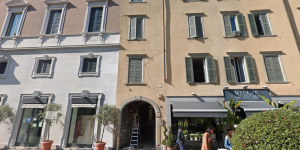
The Protestant Cultural Center is located in Via Tasso, Lower Bergamo, not far from the Province Palace, and is managed by the Waldensian Cultural Center Foundation.
The location is not random: during the Renaissance, the neighborhood that developed around the street had the highest concentration of Protestant Swiss in the city. Many of the palaces that still adorn it were commissioned by those families, enriched through trade.
The Center is located inside civic number 55. After crossing the entrance gate, you proceed inside the portico to the inner courtyard - enclosed between the walls of the ancient Zavaritt palace and columns with round arches - to find the entrance on the right. Inside the building, the Girolamo Zanchi Library is also housed, which preserves over 5000 volumes and the documentary archive of the Waldensian Community, with writings dated from 1805 to the present.
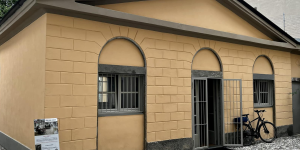
Inaugurated on May 22, 1998, the library has been housed since 2018 within the premises of the Protestant Cultural Center, in a historic building on Via Tasso that, during the Renaissance, was the city's neighborhood with the highest concentration of Waldensians.
The library's collection is naturally specialized, containing 5000 volumes dating from the 1700s to the contemporary era, all related to Protestant character and culture. The sectors cover a wide range: from history to biblical exegesis, theology to literature, philosophy to politics, ethics to law, and education.
The heart of the collection consists of books from the Evangelical Christian Community of Bergamo. Particularly valuable are the core of Italian and foreign biblical editions (18th-19th centuries) and the collection of first Italian editions of Reformed texts.
The library is open to the public for loans and on-site consultation. Since September 2012, it has been part of the National Library Service in the Lombard Regional Pole. It is the ideal place to learn about Protestant history, not only in Bergamo but also in Europe, and to engage in a discussion without confessional or cultural limits.
The facility also houses the archive of documents produced by the Waldensian community in Bergamo from 1805 to 2002. Before recent inventorying, the folders were kept in an cabinet and a box according to the original management methods, which were studied. This also allowed verifying the reliability of the instruments accompanying the archive drafted from 1846 onwards.
Alongside this significant documentary body is all the paperwork produced by the administrative offices of the community, from 1903 to the present.
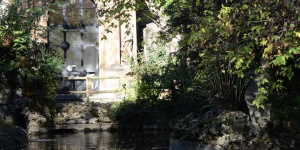
Queste oasi dagli echi romantici, un tempo giardini privati di nobili famiglie, oggi sono racchiuse tra le vie cittadine e dall’esterno paiono soltanto degli insospettabili cortili; è tuttavia sufficiente oltrepassare l’ingresso di uno di questi, il Parco Marenzi e il vicino Parco Caprotti, per rendersi conto di non essere di fronte ad uno scenario qualunque: moltissime specie di piante (alcune anche secolari!), incantevoli vialetti di ghiaia che attraversano entrambi i parchi, grotte in pietra, statue, piccoli tempietti e laghetti, regalano un’emozione che lascia senza fiato: si ha l’impressione di entrare nel mondo delle favole!
Questi due giardini sono ideali per una passeggiata “da sogno” in completo relax immerso nel verde, in centro città.